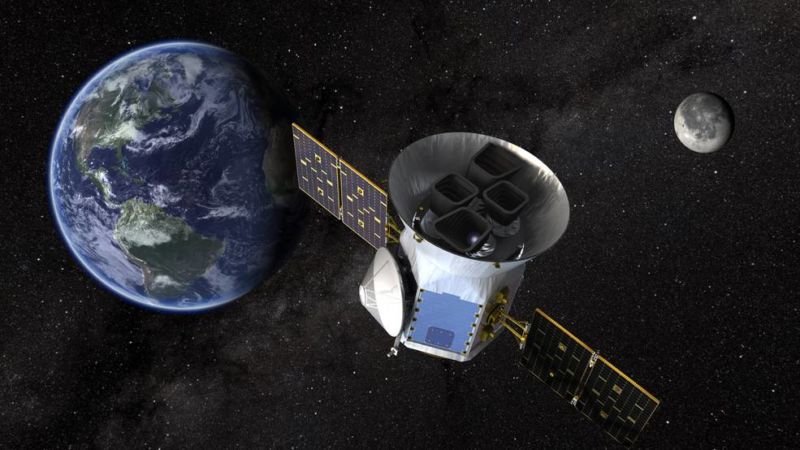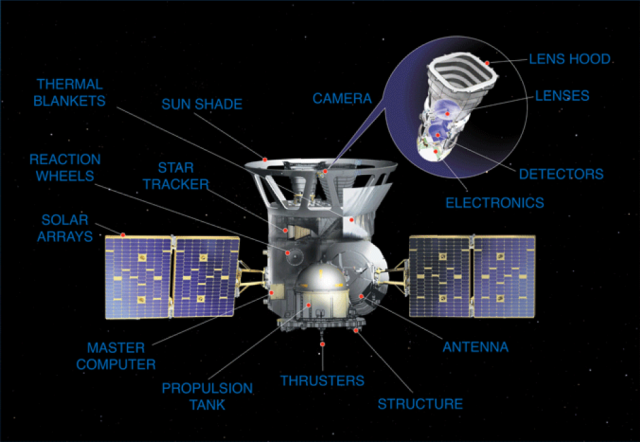
Thanks to the massive trove of exoplanets discovered by the Kepler mission, we now have a good idea of what kinds of planets are out there, where they orbit, and how common the different types are. What we lack is a good sense of what that implies in terms of the conditions on the planets themselves. Kepler can tell us how big a planet is, but it doesn't know what the planet is made of. And planets in the "habitable zone" could be subjected to anything from a blazing hell to a frozen rock.
The Transiting Exoplanet Survey Satellite (or TESS) was launched with the intention of helping us figure out what exoplanets are actually like. TESS is designed to identify planets orbiting bright stars relatively close to Earth, conditions that should allow follow-up observations to figure out their compositions and potentially those of their atmospheres.
Right now, there's a conference happening that's dedicated to describing some of the first discoveries made using TESS. Those discoveries include a three-planet system that seems perfectly positioned to test all of our exoplanet characterization techniques.
What are we looking at?
Both Kepler and TESS identify planets using what's called the transit method. This works for systems in which the planets orbit in a plane that takes them between their host star and Earth. As this occurs, the planet blocks a small fraction of the starlight that we see from Earth (or nearby orbits). If these dips in light occur with regularity, they're diagnostic of something orbiting the star.
This tells us something about the planet. The frequency of the dips in the star's light tells us how long an orbit takes, which tells us how far the planet is from its host star. That, combined with the brightness of the host star, tells us how much incoming light the planet receives, which will influence its temperature. (The range of distances at which temperatures are consistent with liquid water is called the habitable zone.) And we can use that, along with how much light is being blocked, to figure out how big the planet is.

But this leaves a lot of important questions unanswered.
Take a planet that appears to be larger than Earth. It could be rocky, like Earth, placing it in the super-Earth category. But it could also have a dense core surrounded by a thick, gaseous atmosphere, making it a mini-Neptune. Or it could be water-dominated, making for a water- or ice-giant, depending on where it orbits.
That last issue isn't as clear as it seems, either. The temperature of a planet depends in part on its distance from its host star (as well as that star's brightness). Some of that light will be reflected by the planet's surface and any clouds present in its atmosphere. And a fraction of the energy that's absorbed by the planet will be trapped in the atmosphere by greenhouse gasses (including, yes, carbon dioxide).
So the planet's composition and its atmosphere's contents play huge roles in influencing its temperature. At a given distance from a star, it's often possible for these factors to make the difference between a frozen body and one that's hot enough to boil off its oceans.
So, to really understand other planets and their potential to support life, we have to understand what they're made of and what their atmosphere looks like. And, while TESS itself doesn't answer those questions, it's designed to find planets where other instruments could.
Finding things to look at
Fortunately, there are ways of figuring these things out. For example, knowing the size of a planet and its mass tells us its density, which in turn lets us make inferences about its composition. One option is to figure out how much a planet tugs on its host star as it moves about in its orbit. This tugging creates small Doppler shifts in the light coming from the star. This shift allows us to figure out the force the planet is exerting on the star, and thus its mass.
Alternately, if planets' orbits are packed tightly enough, they exert gravitational influences on each other: they speed up or slow down each other's orbits. These transit-timing variations can be registered over time and plugged into models that will provide plausible estimates for the planets' mass.
The transit method also has the potential to give us a sense of what's in the planet's atmosphere. As it passes in front of its host star, a small percentage of the starlight will be absorbed by the gasses in its atmosphere, creating a signature that can reveal the identity of those gasses. While this tiny signal is swamped by the noise in a single transit, observing multiple transits can eventually overcome this limitation.
All of this, however, requires a fair bit of light to start with, which means a bright, relatively nearby star. And we'd need to image multiple orbits, which means the planet in question needs to be orbiting relatively close to its host star.
These are precisely the things TESS is designed to pick up.
The new system
The new three-planet system is called TOI-270, and it's about 75 light years from Earth. The star at the center of the system is a red dwarf, a bit less than half the size of the Sun. Despite its small size, it's brighter than most of the nearby stars we know hosts planets. And—critically—it's stable. That means that variations in the star's light are minimal, and they're less likely to get in the way of trying to pick up subtle changes caused by its orbiting planets.

The three planets have orbital periods of 3.4 days, 5.7 days, and 11.4 days. The ratio among these periods can be expressed as ratios of integers, a feature that's called "orbital resonance."
These resonances tend to stabilize the orbits, keeping the planets' interactions from ejecting one of them from the system or send one diving into the star. Based on the size of the planets, the trio consists of a super Earth as the innermost planet, while the two outer planets are somewhat larger, falling into the class termed sub-Neptunes.
Right now, we only have enough observations of the TOI-270 system to confirm the existence of the three planets. Orbital simulations, however, suggest that a wide range of orbital eccentricities would be stable in the system, so it will take extended observations to figure out the precise details of the orbits.
But, since the longest orbit is under 12 days, that's not so onerous. Once the orbits are figured out, the planets are close enough together to cause transit-timing variations, providing us one avenue toward getting the masses of the planets. They're also large enough and close to the star to drag it around a bit while they orbit, creating Doppler shifts that would allow an independent measurement of the mass.
Significant atmospheres
The outer two planets, which are expected to have significant atmospheres, are prime candidates for studies of their composition. The authors estimate that the James Webb Space Telescope will eventually have a view of the system for over half the year, and it should be able to pick out the atmospheric signals for both planets.
What are we likely to find? All three planets are extremely hot, with only the outermost planet potentially being able to support some liquid water. However, it's also at the edge of boiling off any water into the atmosphere; the authors suggest temperate conditions are more likely on any moons it has. The interactions among the three planets also mean that each is likely to be tidally locked to the host star, which can result in a frigid far side of the planet and a baking star-facing side.
But even if habitability isn't an issue here, the system is definitely worth a careful look. When we have the sort of telescope hardware that will let us detect atmospheres, we'll want to test it out on something where it's likely to work and where we can troubleshoot the inevitable problems that will occur with the analysis. There will also be a learning process with the giant telescopes and James Webb that will be necessary for this work. That makes TOI-270 an important discovery, since it provides the perfect test conditions for exoplanet characterization.
Nature Astronomy, 2019. DOI: 10.1038/s41550-019-0845-5 (About DOIs).
https://arstechnica.com/science/2019/07/tess-mission-finds-nearby-3-planet-system-thats-a-perfect-planet-lab/
2019-07-30 10:45:00Z
52780340023113
Tidak ada komentar:
Posting Komentar